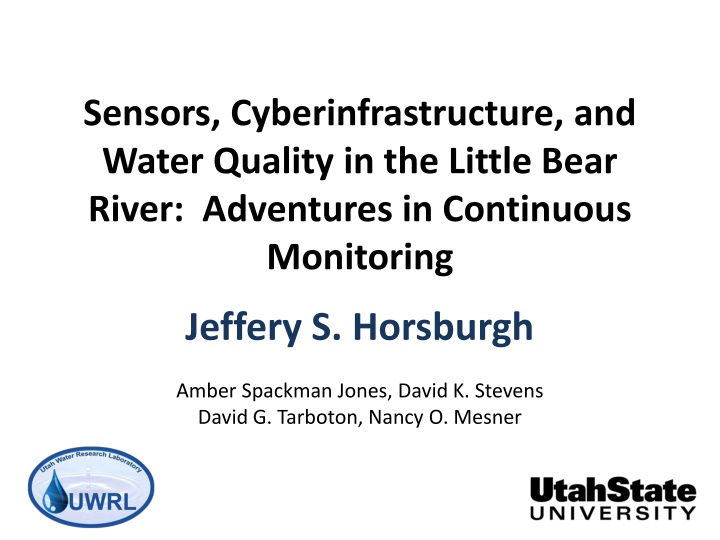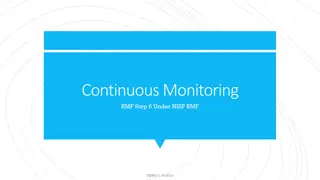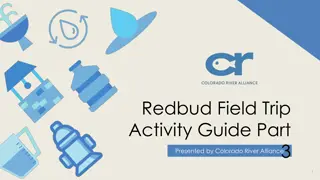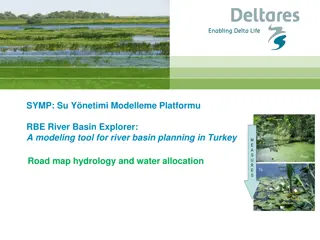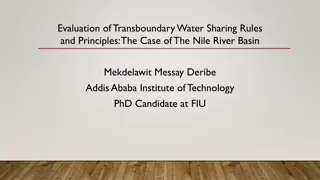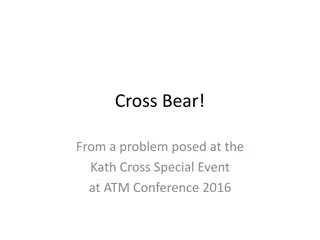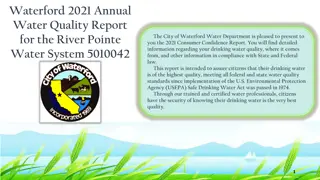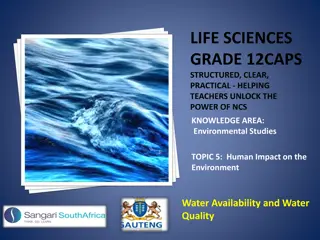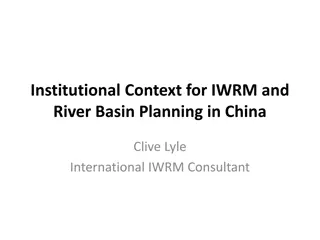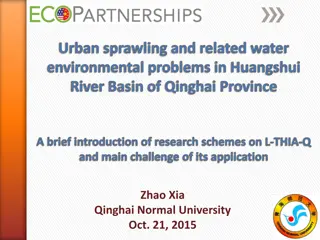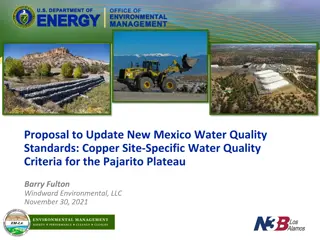Continuous Monitoring of Water Quality in Little Bear River
Explore the implementation of sensors, cyberinfrastructure, and continuous monitoring networks in the Little Bear River to improve water quality predictions. Discover the challenges and solutions related to designing monitoring networks, integrating optical measurements with water quality data, and observing infrastructure for high-frequency estimation of water quality fluxes. Dive into the space and time challenges of monitoring water quality conditions throughout the watershed, understanding sources of pollution, transport pathways, and the impact of natural and human events on water quality changes over time. Experience the Little Bear River Sensor Network's comprehensive monitoring of water quality and streamflow sites, weather conditions, and telemetry network for data collection and analysis.
Download Presentation

Please find below an Image/Link to download the presentation.
The content on the website is provided AS IS for your information and personal use only. It may not be sold, licensed, or shared on other websites without obtaining consent from the author.If you encounter any issues during the download, it is possible that the publisher has removed the file from their server.
You are allowed to download the files provided on this website for personal or commercial use, subject to the condition that they are used lawfully. All files are the property of their respective owners.
The content on the website is provided AS IS for your information and personal use only. It may not be sold, licensed, or shared on other websites without obtaining consent from the author.
E N D
Presentation Transcript
Sensors, Cyberinfrastructure, and Water Quality in the Little Bear River: Adventures in Continuous Monitoring Jeffery S. Horsburgh Amber Spackman Jones, David K. Stevens David G. Tarboton, Nancy O. Mesner
Three Breakout Topics Designing continuous monitoring networks Sensor network telemetry and communication Integrating optical measurements with other water quality data to improve predictions
Observing Infrastructure Horsburgh, J. S., A. Spackman Jones, D. G. Tarboton, D. K. Stevens, and N. O. Mesner (2010), A sensor network for high frequency estimation of water quality constituent fluxes using surrogates, Environmental Modelling & Software, 25, 1031-1044, doi:10.1016/j.envsoft.2009.10.012.
Designing Continuous Monitoring Networks
The Space Challenge How do water quality conditions vary throughout a watershed? As a result of hydrologic features? As a result of different land use? As a result of management practices? What processes (human and natural) drive the variability? Sources - What are the sources of pollution and how much is coming from each source? Transport pathways - How do pollutants reach the water bodies in the watershed? Fate - what happens to the pollutants once they get into a water body?
The Time Challenge How and why does WQ change over time (minutes - years) In response to natural events (seasons, storms, snowmelt, etc.) In response to human events (reservoir management, diversions, return flows, etc.) Are WQ conditions getting better or worse? What might happen in the future? Climate change? Land use change?
Little Bear River Sensor Network 7 water quality and streamflow monitoring sites Temperature Dissolved Oxygen pH Specific Conductance Turbidity Water level/discharge 4 weather stations Air Temperature Relative Humidity Solar radiation Precipitation Barometric Pressure Wind speed and direction Soil moisture and temperature at 5 depths Spread spectrum radio telemetry network
Water Quality Issues Nutrients (Primarily P) Sediment
Pollution Sources Urban Stormwater Runoff Agriculture Wastewater Treatment
Objectives Use high frequency measurements of discharge and turbidity to better quantify suspended sediment and total phosphorus fluxes Design the observing infrastructure required to enable high frequency estimates of constituent fluxes using surrogates Study how high-frequency sensor data collected at multiple sites improve our understanding of hydrology and water quality
Sensor Deployment How do we deploy the sensors so they are: Representative Secure Lots of great guidance out there Every site is different! Can constrain site selection and network design
Have you seen my turbidity sensor? It used to be right here!
Location, Location, Location Access? Can you get permission from the landowner? Can you get there all year long? Does it freeze? Cross section? What sort of telemetry options will work? Power?
The Human Element Huh Why does the river all of the sudden get deeper during the middle of the summer?
Site selection in network design Your research questions matter the space and time challenges Sometimes the right site for the science isn t accessible Detailed scoping is required, and every site is different
Sensor Network Telemetry and Communication
Why Telemetry? The remote technician I don t have to go to the field to check the status of my sensors! Adaptive sampling its raining at my weather station and the stage has increased in the stream, do I change the frequency of my observations? What can we do with data in real time that we can t do with offline data?
Telemetry Network Design Which technologies to choose? Satellite UHF/VHF/spread spectrum radios Ethernet Land line telephone Cellular telephone Mixed networks
Considerations Equipment cost Regular service cost Service availability Terrain Vegetation Distance Required bandwidth Availability Reliability Power Interference Required expertise
Viewshed Analysis Radio telemetry network setup Optimal placement of radio repeaters given monitoring site locations
5.2 Mountain Crest High School Remote Base Station Paradise Repeater UWRL Base Station Computer 1.3 2.9 1.9 Paradise Site East Fork Weather Site C S Confluence Site S 0.6 Lower East Fork Site Key Lower South Fork Site S 2.9 Internet Link Radio Link S 0.8 Stream Monitoring Site S Climate Monitoring Site C Upper South Fork Site S Telemetry
Viewsheds and radios have nothing to do with hydrology and water quality have real time access to data you have to get this expertise but, if you want to network sensors or
Observing Infrastructure Horsburgh, J. S., A. Spackman Jones, D. G. Tarboton, D. K. Stevens, and N. O. Mesner (2010), A sensor network for high frequency estimation of water quality constituent fluxes using surrogates, Environmental Modelling & Software, 25, 1031-1044, doi:10.1016/j.envsoft.2009.10.012.
Hydrologic Information Science It is as important to represent hydrologic environments precisely with data as it is to represent hydrologic processes with equations Physical laws and principles (Mass, momentum, energy, chemistry) Hydrologic Process Science (Equations, simulation models, prediction) Hydrologic conditions (Fluxes, flows, concentrations) Hydrologic Information Science (Observations, data models, visualization Hydrologic environment (Dynamic earth) Slide from David Maidment
The Data Deluge One day = 48 observations One week = 336 observations One month = 1440 observations One year = 17,520 observations Two years = 35,040 observations Three + years = 50,000 + observations Times 7 Sites = 350,000 observations Times 10 + Variables per site = 3,500,000 observations Plus different versions of the data (raw versus checked) = 7,000,000 observations Plus 4 weather stations with 10 + variables = almost 12,000,000 observations You need some infrastructure to manage and share the data.
http://hydroserver.codeplex.com A platform for publishing space-time hydrologic datasets that is: Autonomous with local control of data Part of a distributed system that makes data universally available Basis for Experimental Watershed or Observatory data management and publication system Standards based approach to data publication Accepted and emerging standards for data storage and transfer (OGC, WaterML) Built on established software MS SQL Server, ArcGIS server Open Source Community Code Repository Sustainability
Point Observations Data Internet Applications R.M. Young Wind Sentry Set Ongoing Data Collection Historical Data Files ODM Database GetSites GetSiteInfo GetVariableInfo GetValues GIS Data WaterML WaterOneFlow Web Service Data presentation, visualization, and analysis through Internet enabled applications HydroServer
Observations Data Model (ODM) Streamflow Groundwater levels Precipitation & Climate Soil moisture data Flux tower data Water Quality A relational database at the single observation level Metadata for unambiguous interpretation Traceable heritage from raw measurements to usable information Promote syntactic and semantic consistency Cross dimension retrieval and analysis Horsburgh, J. S., D. G. Tarboton, D. R. Maidment, and I. Zaslavsky (2008), A relational model for environmental and water resources data, Water Resources Research, 44, W05406, doi:10.1029/2007WR006392.
Data Values indexed by What-where-when Time, T t When A data value vi (s,t) Where s Space, S Vi What Variables, V
ODM Supports: different types of data and different needs a number of different queries you can slice and dice the data however you want Many analysis packages (MATLAB and R) can connect directly to a database to get data Supports data publication using the CUAHSI Hydrologic Information System (HIS)
Loading data into ODM ODM Data Loader Interactive ODM Data Loader Loads data from spreadsheets and comma separated tables in simple format Streaming Data Loader (SDL) Loads data from datalogger files on a prescribed schedule Interactive configuration SQL Server Integration Services (SSIS) Microsoft application accompanying SQL Server useful for programming complex loading or data management functions SDL SSIS
Managing Data Within ODM - ODM Tools Query and export export data series and metadata Visualize plot and summarize data series Edit delete, modify, adjust, interpolate, average, etc.
Data Management and Publication Cyberinfrastructure Horsburgh, J. S., and D. G. Tarboton (2010), Components of an integrated environmental observatory information system, Computers & Geosciences, doi:10.1016/j.cageo.2010.07.003. Horsburgh, J. S., D. G. Tarboton, M. Piasecki, D. R. Maidment, I. Zaslavsky, D. Valentine, and T. Whitenack (2008), An integrated system for publishing environmental observations data, Environmental Modelling & Software, 24, 879-888, doi:10.1016/j.envsoft.2009.01.002.
Wait a second Im not a computer scientist! Yes but We are collecting more data higher spatial and temporal resolutions The way we store and manage data can either enhance or inhibit our analyses Visualization and analysis of large datasets can be difficult and require specialized software You will need to share data Are we training our students to work in a data intensive environment?
Data Management Requirements What are the 20 queries that you want to do? e.g., Give me simultaneous observations of turbidity and TSS collected during the spring snowmelt period so I can develop a regression in R. How will you organize and manage your data to satisfy those queries? What are the standards we will use as a community to share data and metadata?
How do Natural Features and Human Activities Affect WQ Conditions? Spatial distribution of total suspended solids fluxes in the Little Bear River for 2008. The areas of the node markers are proportional to the total suspended solids fluxes, which are expressed in metric tons.
Support: EAR 0622374 CBET 0610075 Questions?
